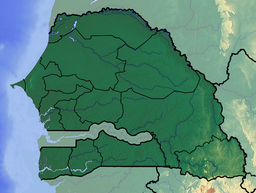Lake Retba
| Lac Rose | |
|---|---|
 Lake shore | |
 Lac Rose | |
| Location | Cap Vert Peninsula |
| Coordinates | 14°50′18.02″N 17°14′41.36″W / 14.8383389°N 17.2448222°WCoordinates: 14°50′18.02″N 17°14′41.36″W / 14.8383389°N 17.2448222°W |
| Type | Saline lake |
| Basin countries | Senegal |
| Surface area | 3 km2 (1 sq mi) |
| Max. depth | 3 metres (9.8 ft) |


Lac Rose (meaning Pink Lake) lies north of the Cap Vert peninsula of Senegal, some 30 km (18 miles) north-east of the capital, Dakar,[1] in northwest Africa.[2] It is named for its pink waters caused by Dunaliella salina algae and is known for its high salt content, up to 40% in some areas.
Description[]
The lake is separated from the Atlantic Ocean only by a narrow corridor of dunes, and is named for its pink waters, which are caused by Dunaliella salina algae. The algae produce a red pigment to help them absorb sunlight, which gives them energy to create ATP.[3] The color is particularly visible during the dry season (from November to June) and less visible during the rainy season (July to October).[4]
Magenta coloured samphire bushes flourish in the lake’s white sandbanks; the sand dunes are terra-cotta-coloured.[citation needed]
Salt[]
The lake is known for its high salt content (up to 40% in some areas), which is mainly due to the ingress of seawater and its subsequent evaporation.[3] Like the Dead Sea the lake is sufficiently buoyant that people can float easily.[1][2][5]
Salt is exported across the region by up to 3,000 collectors, men and women from all over Western Africa, who work 6–7 hours a day. They protect their skin with beurre de Karité (shea butter), an emollient produced from Shea nuts which helps avoid tissue damage. The salt is used by Senegalese fishermen to preserve fish, which is an ingredient in many traditional recipes, including the national dish, which is a fish and rice combination called thieboudienne.[1][6] About 38,000 tonnes of salt are harvested from this lake each year, which contributes to Senegal’s salt production industry. Senegal is the number-one producer of salt in Africa.[7]
The species of fish that inhabit the lake have adapted to its high salt content by evolving ways to pump out extra salt, which keep the fish’s internal water concentration in balance.[8] The fish are approximately four times smaller than those living in a normal environment, as a result of .[9]
However, further research disproves the existence of tilapia in the lake's waters.[10]

World heritage[]
Lake Retba is under consideration by UNESCO as a World Heritage Site.[6]
Motorsport[]
The lake was often the finishing point of the Dakar Rally, before the rally moved to South America in 2009.[5] In 2021, it hosted a round of the Extreme E electric off-road racing series.
See also[]
- Lake Hillier
- Sir Michael Tippett, who composed The Rose Lake after seeing it.
Further reading[]
- "A Look at Lake Retba, Senegal's Pink Lake". Edward Asare. 5 May 2021.
References[]
- ^ Jump up to: a b c Handayani, Wuri; Paramitha, Tasya. "Danau Pink, Sensasi Wisata Apung di Senegal". VIVAnews (in Indonesian). Archived from the original on 14 August 2012. Retrieved 19 June 2012.
- ^ Jump up to: a b "How salt miners save Senegal's Pink Lake". BBC News Online. 19 August 2013.
- ^ Jump up to: a b "Lake Retba in Senegal Looks Like A Giant Strawberry Milkshake". HuffPost. UK. 5 June 2012. Retrieved 9 November 2019.
- ^ "22 Epic Places You Didn't Know Existed". HuffPost. 26 October 2013. Retrieved 9 November 2019.
- ^ Jump up to: a b "Lake Retba". Atlas Obscura. Retrieved 23 May 2013.
- ^ Jump up to: a b Eddy, Jody (14 March 2014). "Swim a Pink Lake in Senegal". The Wall Street Journal.
- ^ Kanoute, Pape Tahirou; Malan, Christiane; Stephane, Fournier; Teyssier, Catherine (2018). "Relevance of a Geographical Indication for Salt From Senegal's Pink Lake" (PDF). Rome: FAO: 16pp. Cite journal requires
|journal=(help) - ^ "Surviving in Salt Water". American Museum of Natural History. Retrieved 9 November 2019.
- ^ "Salt lake fish dwarfism, Senegal - Stock Image - C009/9001".
- ^ Sarr, Raphaël; Debenay, Jean-Pierre; Sow, El Hadji (January 2009). "Enregistrement des fluctuations du niveau marin dans l'Holocène supérieur du lac Retba (Sénégal) par les foraminifères". Revue de Micropaléontologie. 52 (1): 31–41. doi:10.1016/j.revmic.2007.01.008. ISSN 0035-1598.
External links[]
| Wikimedia Commons has media related to Lac rose (Senegal). |
- Lakes of Senegal
- Saline lakes of Africa

